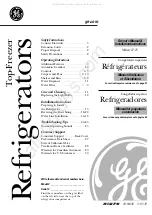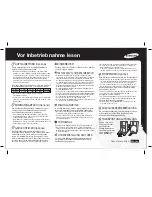
9
Food Storage
To obtain the best performance from your refri-
gerator:
•
Do not store warm food or evaporating liquids.
•
Do not store food uncovered.
•
Keep the time between buying chilled food and
placing it in your refrigerator as short as possible.
•
Do not push food together too much, try to allow
air to circulate around each item.
•
The symbols on the drawers show different types
of frozen goods.
The numbers indicate storage times in months for
the appropriate types of frozen goods. Whether
the upper or lower value of the indicated storage
time is valid depends on the quality of the foods
and pre-treating before freezing.
Energy Saving Advice
•
Do not install the appliance close to sources of
heat, such as a boiler or radiator.
•
Locate the appliance in a cool well ventilated
room and make sure that the air openings of the
appliance are not obstructed.
•
Always leave warm food to cool down to room
temperature before placing in the fridge.
•
Try to avoid keeping the door open for long
periods or opening the door too frequently as
warm air will enter the cabinet and cause the
compressor to switch on unnecessarily often.
•
Ensure there are no obstructions preventing the
door from closing properly.
SOMETHING NOT WORKING
Symptom
No power to the appliance
The light does not come on
The temperature in the fridge or freezer section is
too high
The freezer door will not open
The compressor runs continously
Excessive frost and ice has built up
Noise
Water under the salad bin
Solution
Check there is power at the socket.
Check there is not a power cut by checking the
household lights.
Check the fuse has not blown.
Ensure that the bulb is correctly fitted.
Replace the bulb if it has blown.
Check the door light switch is not jammed.
Check the thermostat control knob in the fridge is
turned to the correct setting relative to ambient
conditions.
Check the ambient temperature is within the
appliance’s operating limits, please refer to the
installation section in this instruction book.
Relocate the appliance if necessary.
Has door just been opened? If so leave for a few
minutes to allow the air pressure to equalise.
Adjust the thermostat control knob to give correct
temperature control. See “Setting the temperature”.
Check that the doors are closed.
Large quantities of food have recently been placed in
the cabinet and/or door is frequently opened.
Check that air ventilation is not obstructed.
Ensure the doors are not left open.
Check that nothing is preventing the doors from
closing.
Is the door gasket intact and clean.
Has advised periodic defrosting been carried out.
Refer to normal operating sounds.
Check the drain hole is not blocked. (see
Maintenance and Cleaning).
If the appliance is not working correctly, please carry out the following checks before calling out an engineer .
Low room temperature operation
During prolonged periods of low room temperatures,ie;10°C and lower, the compressor on single compressor
fridge freezers can remain inoperative during this time .
This is due to the air temperature within the refrigerator compartment being maintained at 6°C or under thus not
calling the thermostat to energise the compressor .
During a normal night time period of approximately 8 hours a traditional fridge freezer can normally maintain the
frozen food temperature but if the appliance is left for longer periods in a low ambient temperature the freezer
will defrost .
12




























